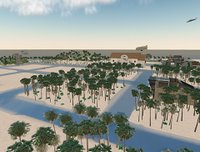 Looking back to the past month I can only identify three major events with a significant impact to the economy (if you think I missed any, just send me an email):
Looking back to the past month I can only identify three major events with a significant impact to the economy (if you think I missed any, just send me an email):
- The Land Bulksales Experiment
- Better Tools for SL Corporations
- Inflation or no Inflation?
Resident-created mainland!
But first ... the raw numbers:
Cold facts
In the last month the official population of Second Life grew a whopping 23% from 105,000 to more than 130,000. This number is disputed by many. All I can say is that all available data on the economics of SL indicatse a growth rate of between 10% and more than 20% per month! In the same time the average number of concurrent users inworld present at 8pm SL time grew some 20% for example. Even the number of sims comprising the world of Second Life has grown by more than 10% (that’s even harder to measure because of all the islands; some hidden).
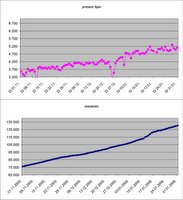 The growth rate of concurrent users online is not as visible as the number of residents because of the large fluctuations. It becomes apparent in the 90day-view, though. It is quite obvious that it is not only the abstract "accounts" that are growing. There are real avatars coming inworld, too - at a growing rate.
The growth rate of concurrent users online is not as visible as the number of residents because of the large fluctuations. It becomes apparent in the 90day-view, though. It is quite obvious that it is not only the abstract "accounts" that are growing. There are real avatars coming inworld, too - at a growing rate.
Folks, Second Life is growing; fast! And anyone who denies that confuses personal experience (“What Growth? Me, I did not see more people than last month”) with hard facts.
The average daily trading volume at the LindeX grew to 5 Mio. L$ per day. That is nearly 18,000

And now back to "events" mentioned:
The Land Bulksales Experiment
The most important event in January was the bulksales test for land IMHO. The Lindens auctioned off blocks of 5, 10, 20 and 50 sims. All of this land is flat but fully terraformable at first. It can be designed by the winning bidder, will thereafter become part of the mainland, and can be sold like any other land. “Land production by residents”, so to speak. This is clearly a sign that Linden Lab wants to retract (completely or in part) from the land creation business. Predictably, the first large blocks went to the only development group in SL which has the resources to digest such a huge chunk: Anshechung.com. And, predictably too, this made some residents furious.

Many facets of this experiment are debateable, IMHO. I would like to see a little more time for preparation and more flexibility afterwards (like it was described here). All in all I guess this is the only way to go with an SL growing as fast as we see it. I am not sure that is was necessary to use the surprise-surprise tactic typical of Linden Lab information policy again and giving the interested parties only one week between announcement and start of the program. But Linden Lab is a “surprising company” in many ways …
The first results of these experiments can be viewed now to the east of the Old Continent: some areas which are patchworks of flat sand islands in the “tropics”, barren snowland and some more varied landscapes too. Of course Anshe and Guni, who signed responsible for the first block of flat little islands, were criticized wildly. (She did some more interesting land later, but that was obviously ignored.) On the other hand: the land sells fast, at least not slower than other mainland areas.
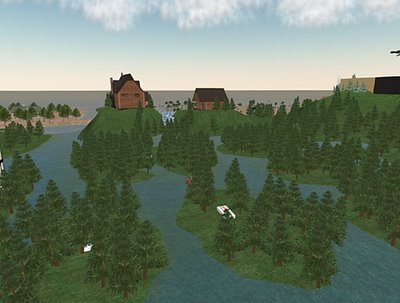
But it seems a little early to me to already pass the verdict on this experiment. I would view all the sims developed so far only as first attempts and I am sure we will see much more interesting solutions (and many more even uglier results) in the coming months. If Linden Lab continues on this way (and I bet they will, with little modifications), in less than 10 months there will be more resident-designed land in SL than the Lindens ever created.
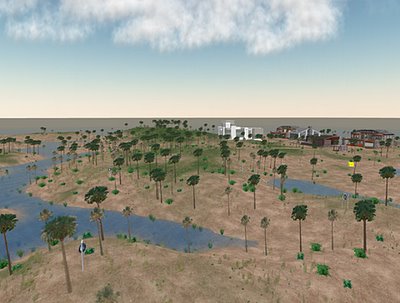
Mainland created by the Cyberland group
This is the future of Second Life land creation – and real estate business. That the business side has changed dramatically was already visible in January. The business model for the “input side” of the real estate market was changed dramatically. Until January, this part of the market consisted of residents with a few thousand US$ in capital, who bought whole sims at prices between 1,000 and 1,500 US$ and resold the land for between 300,000 to 500,000 L$. (I leave the profit calculation as an exercise to the reader. Warning: it is more complicated than it seems.)
Anshechung.com bought the first sims in the new process at 1,000 US$ and tries to resell them at roughly 600,000 L$. Sounds good? Maybe it is good. But please don’t forget that you have to terraform the land in between paying for it and selling and that you have to invest at least 5,800 US$ now (that was the cheapest block sold) to enter the business. Interesting times for the medium sized Land Barons.
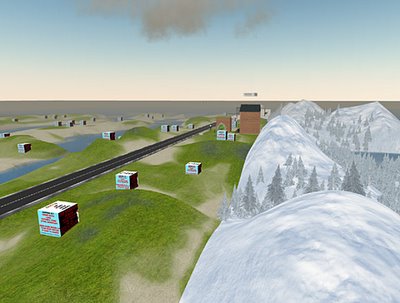
This is what happens when the ideas of different Land Barons about the perfect land clash (hard)
In the long run this new process will influence not only the Land Barons but all residents. It will affect the price of land all over Second Life. It already affected the exchange rate of the L$ (because all players, who want to compete in the market needed US$; fast!) It will of course affect the landscape of Second Life. And it is the harbinger of a new area, where residents will design large areas of Second Life as their personal taste and business plans demands it.
Together with the new estate tools and the new group management tools we will see the growth of large sub-grids, larger than Anshe’s Dreamland today, managed by groups of residents. Before the year is over, we will see at least half a dozen operations of the size Anshechung.com is today.
Better Tools for SL Corprations: New Group and Estate Tools on the Horizon
The Bulksales Experiment can be seen as just one step in an obvious direction. Another step in the same direction is the announcement of new tools and functionalities for groups and estates (private sims). The detailed specifications for these new tools is not available yet. But skimming over the transcripts of the focus group meetings on these topics makes two aspects very clear:
With the new group tools, it will be much easier to build corporations in Second Life than it is now. The days of only three “roles” in the groups (founder, officer, member) with a fixed set of permissions will be gone. It will be possible to give members to have some rights that are now reserved to officers (for example, the right to terraform land, invite new members etc.) but denying them other rights (that to sell land, for example). The pizza guy can’t steal the company anymore to phrase it like a famous resident did it once.
Why is this important? Well, lets look at an example how the current officers in the current groups work: If Anshe takes another officer into one of her land holding groups, this officer can sell all the groups land to himself … for 0L$. So you better be very careful with inviting officers into such a group. On the other hand: one has to be an officer to be able to terraform or cut up land.
This new granularity with group permissions will make it much, much easier to delegate tasks to SL employees with different levels of trust. And this will make it much more practical to have larger corporations.
Another set of new functionalities will come to the owners of “estates” (private sims). They will get the right to sell land (again) and there will be a way to display a kind of binding agreement (“covenant”) before a resident joins a group connected to a private estate. This covenant could describe zoning rules – a kind of “local TOS”. Add two and two together and you get … no, not five, but at least the basic tools to build your own subgrid on a group of private sims. And that is exactly the intention of Linden Lab – as officially stated by Robin Linden in two of these meetings.
Inflation or no Inflation?
One event which “happened” not only in January is the continued de-valuation of the L$. In November one US$ still was worth 252 L$. Now you need more than 280L$ to get one

It is hard for me to subscribe to any of these views. An economy, where the currency falls 6% in one month against the currency of the most important trading partner does not look healthy in RL. And I don’t think it is a good sign for the economy of SL, too. All businesses owners which depend on the exchange of L$ to US$ (most prominently real estate businesses, but others too), will suffer or will have to step up their prices.
I am no expert on monetary policy, but let’s just say: my trust in the
- I knew that Linden Lab cares for the L$, too
- will watch this development closely and
- take some action of deemed necessary
Currently the amount of devaluation can be handled by most profitable businesses. But should this ever develop into a "run", the trust in the economic side of Second Life (which plays an important role in Linden Labs marketing and PR efforts) could easily be lost.
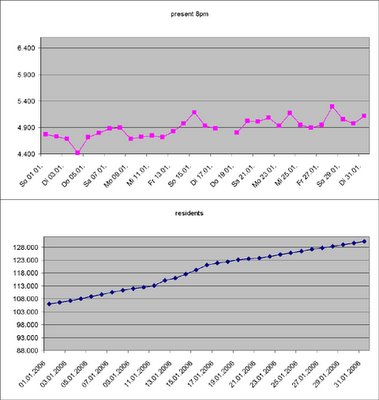
No comments:
Post a Comment